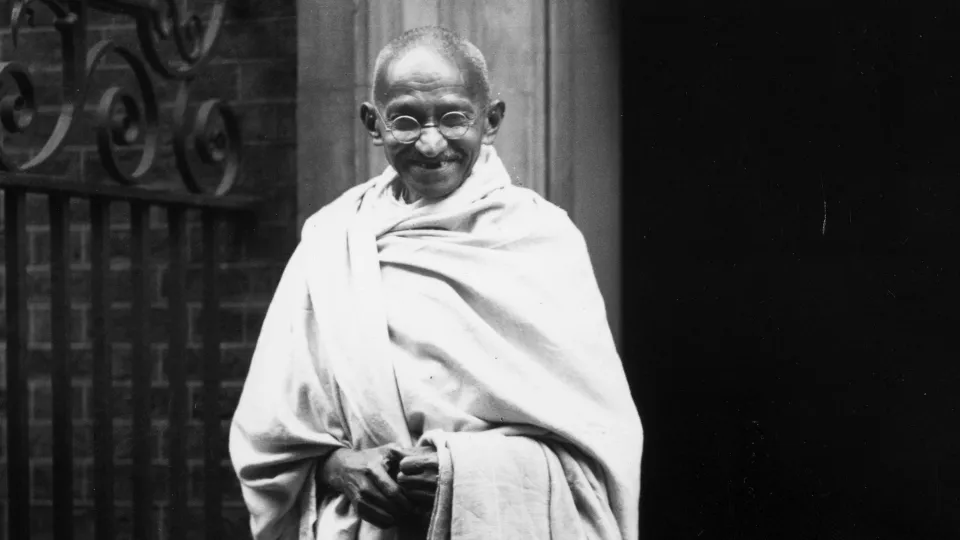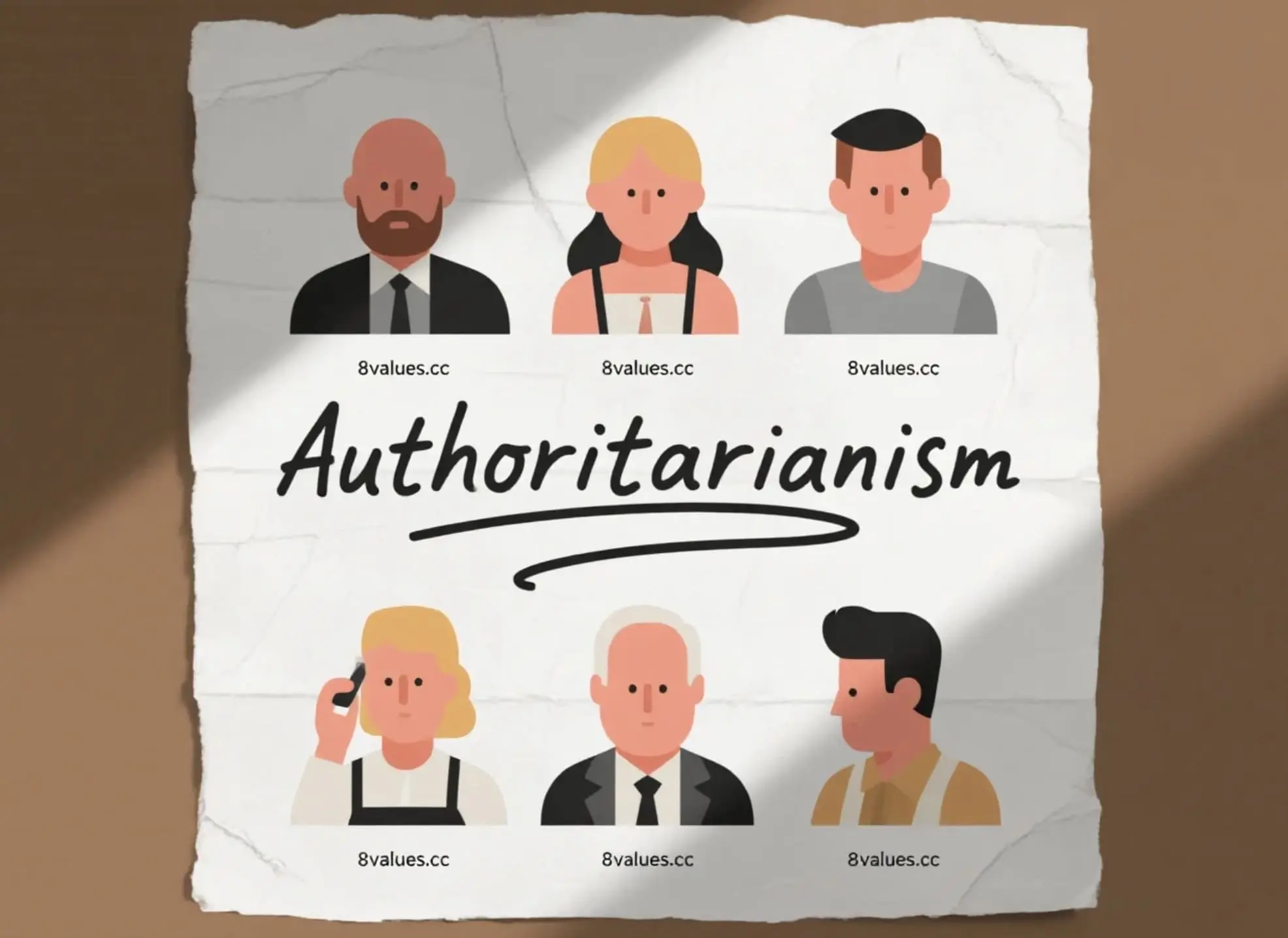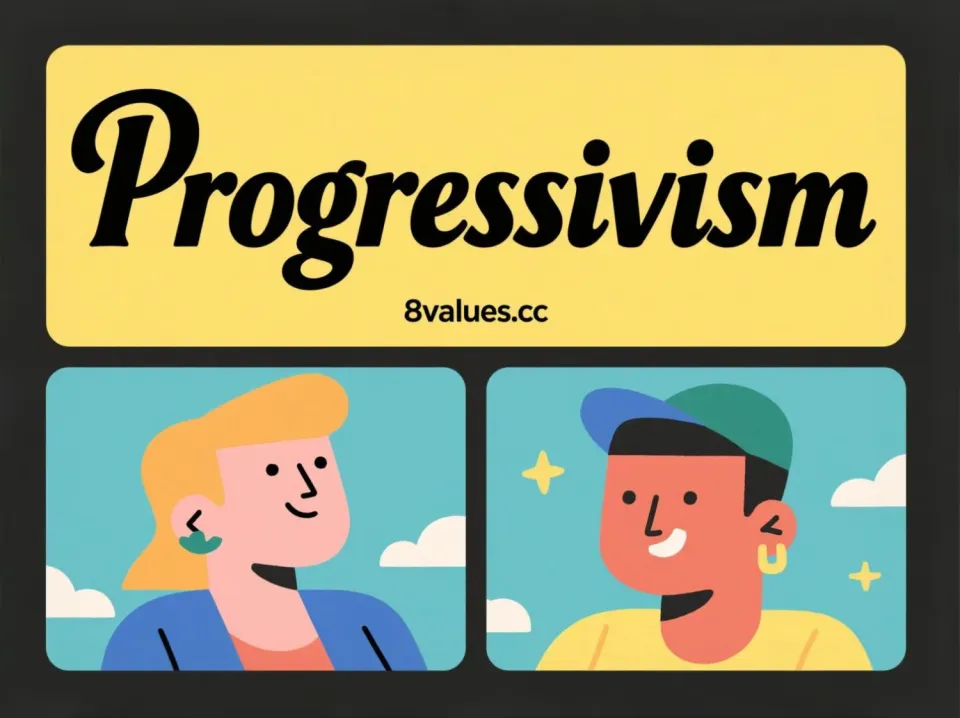Mahatma Gandhi: The Spiritual Leader of Nonviolent Thoughts and Indian National Independence
Explore the nonviolent resistance (Satyagraha) philosophy of Mahatma Gandhi and learn how the founding father of India used his spiritual power to lead the country towards independence. Through the 8 values of political values incident test, you can compare your political beliefs with the core principles of Gandhism.
Mohandas Karamchand Gandhi (2 October 1869 - 30 January 1948) was one of the main leaders of the Indian National Liberation Movement and the soul of the Indian National Congress. With his unique philosophy of "nonviolent resistance" - "Satyagraha", he successfully led India's movement to break away from British colonial rule. Due to its profound influence on human society and international peace and change movements, he was later revered as "Mahatma", which originated from Sanskrit, meaning "great soul" or "respective".
Gandhi is considered the Father of the Nation of the post-colonial India. His birthday, October 2, was designated as the "Gandhi Jayanti" by India and is commemorated worldwide as the "International Day of Nonviolence".
Mahatma Gandhi's early life and thoughts
Gandhi was born on October 2, 1869 in Porbandar, Kathiawar Peninsula, western British India, once a small country in the Kathiawar administrative region. He was born in a Hindu family, belonging to the caste of Modh Bania in Gujarat (a branch of Vaisya, usually engaged in agriculture or commerce).
Gandhi's father, Karamchand Gandhi (1822–1885), served as the Prime Minister of Borbond and Rajkot. His mother Putlibai (1844–1891) was from the Pranami Vaishnava Hindu family and was a very religious woman. Gandhi was deeply influenced by his mother and learned virtues such as morality and truth from an early age, and developed a character of being loyal to his parents, sticking to his duties, and aversion to lies.
In May 1883, Gandhi, who was only 13 years old, married Kasturbai Gokuldas Kapadia (nicknamed "Kastbar" or "Ba") as local customs. In the years after their marriage, Gandhi's father died in the late 1885.
In September 1888, 19-year-old Gandhi went to London, England to study law at Inner Temple, aspiring to become a lawyer. During his three years in London, he joined the London Vegetarian Society (LVS) and met members of the Theosophical Society, who encouraged Gandhi to read the Bhagavad Gita. During this period, Gandhi also studied the works of the Bible, the Qur’an, Henry David Thoreau, as well as Leo Tolstoy’s The Kingdom of God Is Within You and John Ruskin’s Unto This Last. These study activities helped him understand the essential doctrines of different religions and formed his own view that various religions have a consistent inner spirit and a common "humanitarian" principle.
In June 1891, Gandhi obtained the lawyer qualification and returned to India, but his lawyer business in his hometown and Mumbai did not go well.
The civil rights movement and the formation of nonviolent resistance (Satyagraha) in South Africa
In April 1893, Gandhi, 23, was invited by a Muslim company to go to the Colony of Natal in British South Africa to handle legal disputes. He originally planned to stay for only one year.
As soon as he arrived in South Africa, Gandhi suffered racial discrimination for his skin color and background, including being driven out of the first class carriage and being asked to remove his headscarf at a Durban court. These experiences led him to question the Indians' status in the British Empire. He decided to defend his rights through struggle.
Gandhi lived in South Africa for 21 years, during which he developed his political views, ethics and political approaches. For the first time, he practiced the concept of nonviolent resistance there.
In 1894, in an effort to oppose a new bill aimed at depriving Indians of the right to vote, Gandhi extended his stay in South Africa and founded the Natal Indian Congress. Through this organization, he has shaped the Indian community in South Africa into a unified political force.
During his time in South Africa, Gandhi's core philosophy "Satyagraha" began to take shape. Gandhi first adopted this still evolving methodology at a massive protest rally in Johannesburg in 1906. Satyagraha originated from Sanskrit, meaning “relying on truth” or “holding on truth”. It emphasizes the unity of love and truth, and is a weapon of the strong, advocating that you would rather sacrifice yourself than exert violence against your enemies.
In 1910, Gandhi and Hermann Kallenbach established the ideal community near Johannesburg, the Tolstoy Farm. There became one of the bases of the "nonviolent resistance movement".
Although Gandhi focused on Indian civil rights struggles in South Africa, he has also been criticized, such as his early remarks that distinguished Indians from Africans. However, his life studies show that his later views are constantly evolving. Eventually, his anti-racist efforts in Africa won the admiration of later generations such as Nobel Peace Prize winner Nelson Mandela.
Gandhi's nonviolent resistance movement in South Africa climaxed in 1913, leading more than 2,000 Indian miners and families to "peaceful march" in Transvaal, demanding the abolition of discriminatory bills. Despite Gandhi's multiple arrests, the movement eventually forced the South African government to make concessions, announcing the abolition of the poll tax and recognizing the legality of religious ritual marriage in India.
Leading the Indian National Independence Movement (The Struggle for Swaraj)
On January 9, 1915, Gandhi, 45, returned to India at the invitation of Gopal Krishna Gokhale. He soon devoted himself to political life in India and took over and led the work of the National Congress of India (Congress).
The beginning of local protests and non-cooperation movements
Gandhi made a major achievement in India for the first time in Champaran in 1917 and Kheda in 1918. He organized farmers, farmers and urban laborers to protest discrimination and excessive land taxes.
During World War I, Gandhi supported Britain's war efforts in exchange for post-war India's autonomy (swaraj, self-made/autonomous). However, the reforms provided by Britain were far from meeting the requirements of autonomy, which shook Gandhi's belief in cooperation with Britain.
In 1919, the UK passed the Rowlatt Act, which allowed the government to treat civil disobedience participants as criminals and to conduct indefinite preventive detention without judicial review. Gandhi announced that it would carry out a civil disobedience movement to "uphold the truth".
The Amritsar massacre that same year led to hundreds of unarmed civilians being shot and killed by British troops. This incident, along with the British reaction, convinced Gandhi that India would never be treated fairly under British rule and prompted him to turn his attention to fighting for India's "autonomousness" and political independence.
During this period, Gandhi also supported the "Khilafat Movement" in order to win cooperation between the Muslim community in opposing British imperialism.
"Non-violent non-cooperation movement" and "Gateway Movement" (Khadi)
In 1920, Gandhi formally proposed the idea of adopting a "non-cooperation" attitude towards Britain, transforming the strategy of struggle from a "non-violent resistance movement" to a "non-violent non-cooperation movement."
In 1921, Gandhi began to serve as the Congress leader, and he extended his non-cooperation program to include the "swadeshi" policy - boycotting foreign goods, especially British goods. He advocated that all Indians wear khadi spinning cloth (khadi) spun by hand-rock spinning wheels as a symbol of identification with the poor in rural India and support the independence movement. In addition, he urged people to boycott British institutions and resign from government positions, aiming to paralyze the British Indian government economically, politically and administratively.
In 1922, due to the use of violence by the masses in the Chauri Chaura incident, Gandhi decided to stop the national non-cooperation movement out of concerns about the escalation of violence, which caused strong dissatisfaction inside and outside the Congress Party. Gandhi was subsequently arrested by colonial authorities and sentenced to six years in prison for incitement. He wrote his autobiography "The Story of My Experiments with Truth" in prison.
Salt March and the Civil Disobedience Movement
In March 1930, Gandhi launched a new "Satyagraha" campaign against the British salt tax - "Salt March". He condemned the rule of Britain as a "curse".
From 12 March to 6 April 1930, Gandhi led 78 volunteers on foot 388 km (241 miles) from Ahmedabad to Dandi, Gujarat, to make salt in person to blatantly violate the British salt monopoly law. Thousands of Indians joined his ranks. The movement mobilized all walks of life in Indian society, especially to attract thousands of women.
Despite Gandhi's arrest and British authorities used violence to suppress subsequent protests, the movement was one of Gandhi's most successful movements, shaking Britain's dominance over India.
Subsequently, Gandhi–Irwin Pact was signed with Gandhi–Irwin Pact with Gandhi Governor Lord Irwin. Under the agreement, the movement for civil disobedience was suspended and all political prisoners were released. Gandhi, the only representative of the Indian Congress, was invited to London to attend the Round Table Conference.
Exit India movement
After the outbreak of World War II, Gandhi opposed India's participation in Britain's war efforts, and he believed that India should not participate in a war claimed to be fighting for democracy and freedom when it was deprived of its liberty.
In 1942, Gandhi delivered the famous Quit India speech, demanding that Britain immediately evacuate India. He urged the Indian people to "stop co-operating with the imperial government" and called on them to "do or die " to fight for their rights and freedoms.
The British government quickly arrested Gandhi and all the main leaders of the Congress. Gandhi was imprisoned for two years at the Aga Khan Palace in Pune. During this period, his wife Kasturba died in 1944.
The tragedy of religious pluralism and the partition of India and Pakistan
Gandhi has always advocated the establishment of an independent India based on religious pluralism. He tried to shape the Congress into a large organization that unites all classes of Hindus, Muslims, Sikhs and Untouchables.
However, in the early 1940s, Muslim nationalism challenged Gandhi's vision to establish an independent Muslim homeland within British India. The Muslim League grew stronger during the imprisonment of Congress leaders.
Gandhi strongly opposed India's division based on religious boundaries. He had extensive correspondence and meetings with Muhammad Ali Jinnah, but Jinnah rejected Gandhi’s proposal for a unified, religiously diverse India coexistence.
In 1946, Jinnah called for Direct Action Day to promote division, resulting in large-scale religious violence in Calcutta.
In August 1947, Britain finally approved independence, but the British Indian Empire was split into the Hindu-majority India and the Muslim-majority Pakistan. Before and after the partition, large-scale religious violence broke out, killing hundreds of thousands of people and forced to move between 10 and 12 million.
Gandhi did not attend the official independence celebration. He traveled to affected areas to call for a halt of religious conflict through fasting and protests and prompted the government to resolve the asset allocation dispute with Pakistan.
Assassination of Mahatma Gandhi and the Eternal Legacy of Nonviolence
On January 30, 1948, when Gandhi was 78 years old, he was killed by the Hindu radical nationalist Nathuram Godse on his way to an interfaith prayer meeting at Birla House in New Delhi. Goldse later claimed that Gandhi was assassinated because he believed Gandhi was too determined to defend Indian Muslims and support Pakistan.
After Gandhi was assassinated, India's whole country was grieving. Then Prime Minister Jawaharlal Nehru delivered a radio speech saying: " The glory in our lives has disappeared, and the whole country is immersed in the darkness ." More than one million people participated in Gandhi's funeral parade. Gandhi was cremated according to Hindu tradition.
Core beliefs and practices: truth, non-violence and self-restraint
Gandhi's philosophical thought was not only a guideline for the Indian national independence movement, but also a complete doctrine based on moral ethics and spiritual power, commonly known as Gandhism.
1. Truth (Satya) and Stick to Truth (Satyagraha): Gandhi devoted his life to discovering and pursuing truth (Satya). He believed that "God is the truth", and later revised it to "Truth is God". He named the political movement "Satyagraha", which means "reliance on or upholding the truth." At the heart of Satyagraha is the “power of soul” or “power of silence”, which refuses to use violence, seeking to transform or “purify” the oppressors by enduring pain, self-sacrifice and non-co-operation (non-co-operation) to make “love overcome hate”. He stressed that if you want to cultivate a true democratic spirit, you cannot tolerate dissent.
2. Nonviolence (Ahimsa): Although the concept of nonviolence (Ahimsa) has a long history in Indian religious thoughts such as Hinduism, Jainism and Buddhism, Gandhi was the first to apply it to the political field on a large scale. Ahimsa is the foundation of Gandhi's philosophy, and he believes that the only means to achieve truth is non-violence, because love is human nature and the principle of truth is the principle of love. However, Gandhi also said that he believed nonviolence was “infinitely superior to violence”, but he would rather India resort to force to defend its honor than it cowardly becomes or maintains a helpless bystander to itself .
3. Spiritual and Ethical Practice (Brahmacharya): Gandhi’s spiritual practice is based on the five oaths of Hindu yoga philosophy: truth (Satya), non-violence (Ahimsa), ascetice (Brahmacharya, abstinence/celibacy), non-theft (Asteya) and non-attachment (Aparigraha). Brahmacharya for Gandhi means sexual and food control. He believes that sex life is inconsistent with his moral goals. To test and prove his abstinence determination, he conducted a series of controversial experiments after his wife's death, including sleeping with young women. Although these experiments have been widely criticized by family and politicians, Gandhi believes that this is the condition he needs to achieve a "abstinence".
4. Economic and Social Thought: Gandhi's social reform movement aims to eliminate the stain on Hinduism - "untouchability". He affectionately called the untouchables "Harijan", meaning "Son of God" and called for improvement of their living conditions. Economically, Gandhi advocated the village-dominated economy, praised the traditional rural manual labor methods, and vigorously criticized the production of large machines as the source of exploitation and destruction of people's spirit. His economic thoughts are reflected in his translated and interpreted John Ruskin's book Unto This Last.
Literary Contributions and Writings
Gandhi is a prolific writer. His writing style is concise, precise and clear, and he strives for naturalness. One of his earliest publications was Hind Swaraj or Indian Home Rule, published in Gujarati in 1909, a book considered the "blueprint of knowledge" for the Indian independence movement. His autobiography, The Story of My Experiments with Truth, records his ideological development and life experience in detail. In addition, he has edited several newspapers and journals, including Indian Opinion, Young India and Navajivan. The Indian government published the "The Collected Works of Mahatma Gandhi" in the 1960s, with a total of about 100 volumes and about 50,000 pages.
Historical status and global influence (Gandhi's Global Legacy)
Gandhi is recognized as the greatest figure in successfully leading India out of British rule.
Political and cultural heritage
- Indian founding father: Indians generally believe that Gandhi is the "founder of the founding father", and the title can be traced back to the name of Gandhi in 1944 when Subhash Chandra Bose spoke on a radio station.
- Global Idol: In 1999, Gandhi was named "Asian Century Figure" by Asiaweek; in a 2000 BBC poll, he was selected as "the greatest figure in the millennium".
- Memorials and Honors: There are countless streets, roads and areas throughout India named after Gandhi. All denomination notes issued in India have portraits of Gandhi. The Raj Ghat in New Delhi is its cremation site, a black marble platform. The Birla House, where Gandhi was assassinated, has now become the Gandhi Smriti Memorial.
Inspiration for world political thought
Gandhi has profoundly influenced the civil rights and freedom movements around the world.
- Civil Rights Movement in the United States: Leaders of the American civil rights movement, including Martin Luther King Jr., James Lawson and James Bevel, have drawn nonviolence theories from Gandhi's writings. Martin Luther King once said: "Christ gave us goals, and Mahatma Gandhi gave us tactics."
- South Africa and Mandela: Anti-apartheid activist and former South African president Nelson Mandela was inspired by Gandhi's philosophy of nonviolent resistance. Scholars believe that Mandela "completed the career that Gandhi began."
- Albert Einstein's evaluation: Physicist Einstein praised Gandhi as a role model for later generations. He believed that Gandhi's life achievements were "unique in political history" and he invented a "new and humane" way to liberate oppressed countries. Einstein also said: " It may be difficult for future generations to believe that such people have actually appeared in the world ."
In the contemporary era, Gandhi's thoughts remain important, especially his view on technology and economy has regained attention in the fields of environmental philosophy and technological philosophy.
Controversy and criticism
Despite Gandhi's lofty status in India and around the world, his life and method have also been criticized and controversial.
British politician Winston Churchill is a strong critic of Gandhi's long-term plan. Churchill has repeatedly ridiculed Gandhi for being a "stigmatized lawyer" and dressed up as "a common ascetic monk in Eastern people" and called him "Hindu Mussolini."
Untouchable leader BR Ambedkar has criticized Gandhi several times. He believed that Gandhi's thoughts were primitive, influenced by the mistakes of Tolstoy and Ruskin, and refuted some of Gandhi's views. Ambedkar once pointed out in an interview with European reporters that Gandhi talked about achieving equal India in front of Westerners, but in the Hindu media, he talked about India's inseparable from the caste system.
Furthermore, Gandhi's ascetic experiments, especially his test behavior of sleeping with young women, caused great controversy and moral criticism both before and after his death.
The Relationship between Gandhi's Thought and Political Ideology
Gandhism, as a unique political theory, is at its core, truth and non-violence, which has profoundly influenced the political direction of the Indian National Congress Party.
If you are interested in complex and multi-dimensional politicians like Gandhi and the ideology they represent, you can try to conduct in-depth analysis. Gandhi's thoughts blend spiritual, social improvement and political strategies, and are separated from the traditional definition of the political spectrum.
For users who want to understand their political tendencies, we recommend you to use the 8values Political Values Prone Test . By testing, you can compare your tendencies with the ideas of pacifism, nonviolence, social justice, etc. that Gandhiism encompasses, to better understand how these complex 8 values all results ideologies evolved historically into concrete political action.
The "autonomousness" (Swaraj) advocated by Gandhi is not only political independence, but also self-control and moral perfection of individuals and communities, which reflects the depth of his thoughts and extraordinary ethical requirements. His life was a series of "experiments" about morality, truth, non-violence and political practices that still inspire social reformers around the world. For more exciting content, please continue to browse our official blog .







